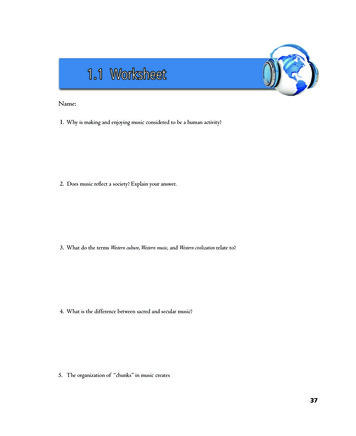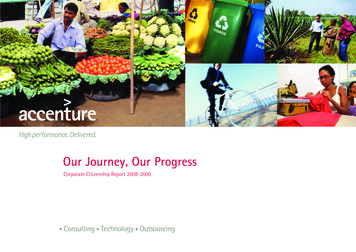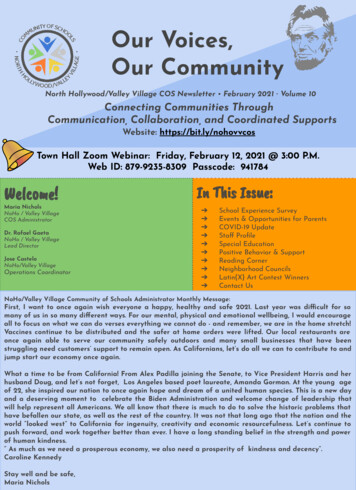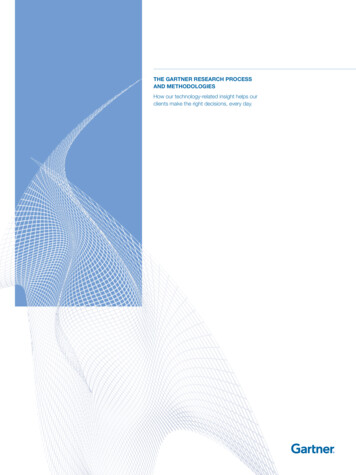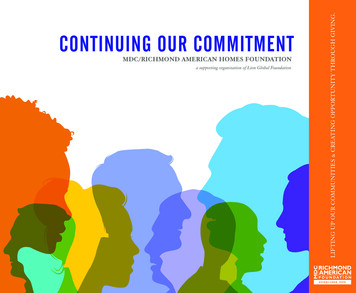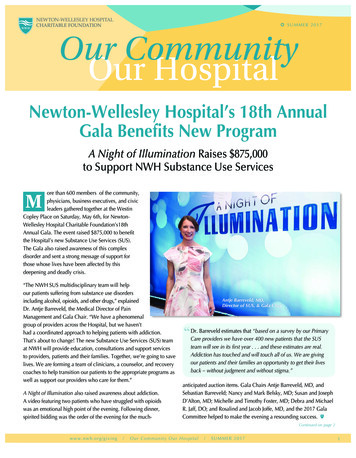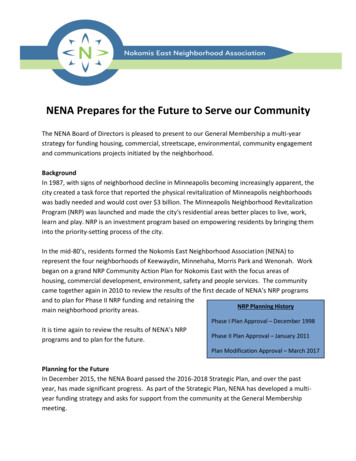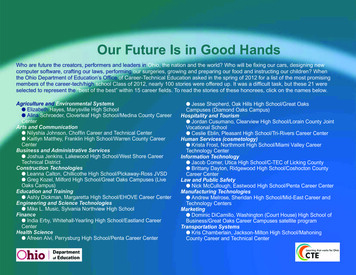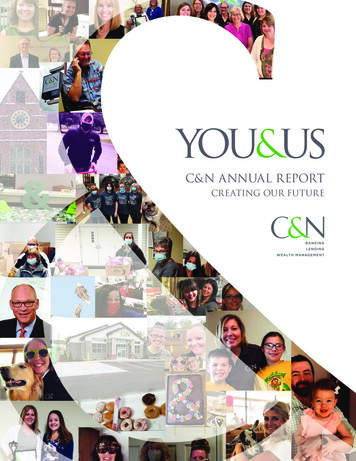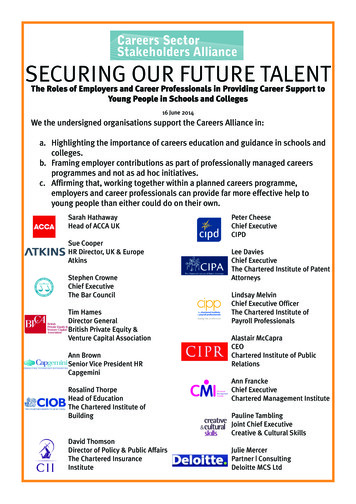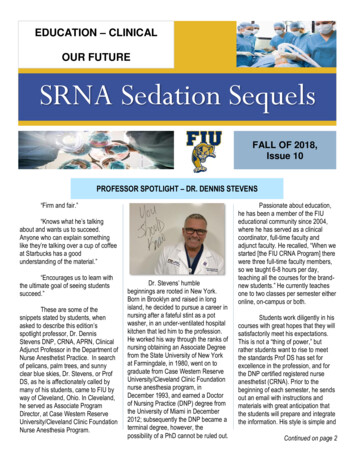
Transcription
EDUCATION – CLINICALOUR FUTURESRNA Sedation SequelsFALL OF 2018,Issue 10PROFESSOR SPOTLIGHT – DR. DENNIS STEVENS“Firm and fair.”“Knows what he’s talkingabout and wants us to succeed.Anyone who can explain somethinglike they’re talking over a cup of coffeeat Starbucks has a goodunderstanding of the material.”“Encourages us to learn withthe ultimate goal of seeing studentssucceed.”These are some of thesnippets stated by students, whenasked to describe this edition’sspotlight professor, Dr. DennisStevens DNP, CRNA, APRN, ClinicalAdjunct Professor in the Department ofNurse Anesthetist Practice. In searchof pelicans, palm trees, and sunnyclear blue skies, Dr. Stevens, or ProfDS, as he is affectionately called bymany of his students, came to FIU byway of Cleveland, Ohio. In Cleveland,he served as Associate ProgramDirector, at Case Western ReserveUniversity/Cleveland Clinic FoundationNurse Anesthesia Program.Dr. Stevens’ humblebeginnings are rooted in New York.Born in Brooklyn and raised in longisland, he decided to pursue a career innursing after a fateful stint as a potwasher, in an under-ventilated hospitalkitchen that led him to the profession.He worked his way through the ranks ofnursing obtaining an Associate Degreefrom the State University of New Yorkat Farmingdale, in 1980, went on tograduate from Case Western ReserveUniversity/Cleveland Clinic Foundationnurse anesthesia program, inDecember 1993, and earned a Doctorof Nursing Practice (DNP) degree fromthe University of Miami in December2012; subsequently the DNP became aterminal degree, however, thepossibility of a PhD cannot be ruled out.Passionate about education,he has been a member of the FIUeducational community since 2004,where he has served as a clinicalcoordinator, full-time faculty andadjunct faculty. He recalled, “When westarted [the FIU CRNA Program] therewere three full-time faculty members,so we taught 6-8 hours per day,teaching all the courses for the brandnew students.” He currently teachesone to two classes per semester eitheronline, on-campus or both.Students work diligently in hiscourses with great hopes that they willsatisfactorily meet his expectations.This is not a “thing of power,” butrather students want to rise to meetthe standards Prof DS has set forexcellence in the profession, and forthe DNP certified registered nurseanesthetist (CRNA). Prior to thebeginning of each semester, he sendsout an email with instructions andmaterials with great anticipation thatthe students will prepare and integratethe information. His style is simple andContinued on page 2
SRNA Sedation SequelsTABLE OF CONTENTSProfessor Spotlight – Dr. DennisStevens .1-2AANA 2018 Annual Congress .3DNP Symposium .3Clinical Spotlight – Henry Gotor.4FANA 2018 Annual Meeting .4Community Engagement Event .5Clinical Spotlight – AlbertoGonzalez .5Studying Tips and Habits .6-7Brazilian Jiu-Jitsu 7Stress Management Techniques .8Crossword .9Recipe: Bell Pepper KetoNachos .10Faculty Spotlight – Story 11Answers to Previous CrosswordPuzzle 11Upcoming Events .11From the Dean 12Page 2CONTINUED FROM COVER PAGEdirect, “I know a student understands the concept when they are able tocommunicate it using simple terms.” During lectures, he initiates studentengagement by asking questions where students need to unpretentiously conveya complex system or concept.It was his sincere desire to give back to the nursing profession that ledDr. Stevens to teaching. Beyond the formal walls of academia, he started bygiving short lectures related to clinical practice in the intensive care units atJackson Memorial Hospital. Asked about his motivation for teaching he says, “Iwant to give back to a profession that I am passionate about, impart someknowledge to students, and make a difference in a student’s pursuit of becominga CRNA.” He adds, “As an educator, it is my responsibility to teach, and thestudent’s responsibility is to learn. I will give of myself 110%, yet I expect 120% inreturn from the students.”His tenure with the FIU CRNA program has allowed him to witness itsevolution. Among the greatest advances, is the simulation (SIM) lab, which hasprovided students with greater ease in practice. Dr. Stevens recalls a time whenFIU students practiced spinals on lemons. The lemon technique was obviouslyeffective, but the ability to run through scenarios in a clinical-like setting withequipment is a powerful training tool. Anesthesia requires students to have a fairgrasp of multiple subjects and complex concepts. SIM helps with the synthesis ofinformation.In the classroom, clinical setting and SIM, Dr. Stevens strives to conveydifficult information in a concise manner. He presents material a way thatstudents not only understand it, but can relate to it, and use it in clinical practice.“I love the ‘okay, now I get it moments,’ that students have in the OR and theclassroom,” he said of his simple approach.Outside of the classroom, he spends his days with Bob Rusnak (Mr.Bob), who is also a CRNA and Professor Stevens calls his life partner. Marriedfor the last two years, in January 2019, they will celebrate their 37th anniversarytogether. He said, “I believe in long engagement periods and wanted to makecertain ‘it would last.’ I am confident it will ” Together with their two rescue cats,Maggie and Baxter, the pair of self-proclaimed-homebodies, love spending timein their homes in Palm Beach Gardens and on the coast of Maine.Upon asking his recommendations for success in CRNA school, youshould know that Dr. Stevens said, “Anesthesia school will be your most rigorousundertaking, yet it will be the most rewarding. I view anesthesia school as aseries of stressors you adjust to the current stressor then move to the next. Lookahead and appreciate how far you have come since you started! You need to beorganized, focused, and learn to multi-task. Remain humble throughout youreducational process and nurse anesthesia career. Always remember, ourpatients come first, and as nurses we are their advocates at all times.”Irahisa Cabral, SRNA C/O 2020
SRNA Sedation SequelsPage 3AANA 2018 ANNUAL CONGRESSThe American Association of Nurse Anesthetist (AANA) began in 1953 and continues to reshape patient care bychallenging current modalities. The 2018 AANA Poster Conference in Boston, Massachusetts provided one of the largestgatherings in history of Certified Registered Nurse Anesthetists (CRNAs) and Student Registered Nurse Anesthetists(SRNAs). This event brings all nurse anesthesia educational programs under one roof to examine existing literature andpresent practice recommendations to mitigate issues often undermining patient health.The poster presentations were judged on the following areas: background literature review, problem andhypothesis, methods, result, conclusion, and future research application. Students disseminated their findings via visual/oralposter presentations to the AANA board committee and other prospects surrounding their cubicle. All participants may beconsidered winners, in my opinion, as they’ve expanded an ever-growing knowledge base and contributed towards a bettertomorrow.Izaskun Green, SRNA C/O 2018DNP 2018 SYMPOSIUMAfter a long journey of research and exploration, the Class of 2018 has finally reached the end of their DNP ScholarlyProjects. The time had come to demonstrate their hard work on topics of interest to colleagues, faculty, and other healthprofessionals via a PowerPoint or poster presentation at the DNP Symposium on November 17, 2018.The event began with a presentation by Ms. Nicole Shay, a guest speaker from Mallinckrodt Pharmaceuticals. DeanOra Strickland welcomed all students and guests. The DNP students presented their projects simultaneously in two rooms(poster and podium presentations). A variety of interesting research was exhibited, including complimentary techniques forpediatric anxiety, the use of ketamine for chronic pain and depression, opioid therapy in certain adult patients experiencingchronic pain, and so on.The presenters were asked numerous challenging questions regarding the evidence they found and were stimulatedby the guests’ perspectives. The information offered was inquired in depth by experienced professionals in the field, whowere all intrigued by their work. Overall, the DNP Symposium was a unique experience, and also aided the Class of 2019 onwhat to anticipate and how to prepare for these presentations when the time comes.Sandra Amoretti, SRNA C/O 2019
SRNA Sedation SequelsCLINICAL SPOTLIGHTPage 4FANA 2018 ANNUAL MEETINGMercy HospitalHenry GotorAs a student, we rotatethrough many clinical sites and meet amultitude of preceptors, but someimpact us more than others. This is thecase with Henry Gotor, the chiefCRNA at Mercy Hospital. His passion,dedication, and love for the professionare among one of the things I admirethe most about him. His carefreeattitude and knowledge are only a fewof the reasons why students feel he isa great preceptor.Henry has been a CRNA forover ten years. Henry became aCRNA because he wanted to work in achallenging environment that was alsorewarding. He attended BarryUniversity where he graduated with aMaster’s degree in Nurse Anesthesia.Henry is happily married and has twobeautiful children. His hobbies includefishing, hunting, and spending timewith his family.Henry believes that the key tolearning is real hands-on experienceand that a preceptor’s number onepriority is to provide a stress-freeenvironment that is conducive tolearning. According to Henry,“students learn better when they are ina setting that fosters positivereinforcement.” His advice for studentscurrently in the program is to “havefun, be humble, and treat everyrotation as a possible on-the-jobinterview.”Oscar Ruque, SRNA C/O 2019FANA symposium differedvastly from the 2018 Sand and Surf,offering a variety of lectures for CRNAsand conferences geared towardSRNAs. Two thousand eighteen was abusy year for the Florida Association ofNurse Anesthetists (FANA) as electionscame to an end and all elector positionswere presented midday on Saturday,October the 20th.Guest lectures presented topicsregarding patient safety, understandingultrasound, and understandingfluoroscopy imaging. A similar trendwas felt throughout all the FANApresentations, a step toward regionalanesthesia. SRNA lectures wereultrasound guidance regionalanesthesia understanding the block andanatomy; luckily, for the two SRNAstudents that attended the FANAmeeting, that information was alreadyreceived from our school lectures.The presentations were a greatreview provided by Jonathan KlineMSNA, CRNA. They offered an onscreen display of the brachial plexus inthe upper extremities lecture. During thelower extremity lecture, there was adisplay of a popliteal block and theanatomical lecture portion displayedwith real-time ultrasound. A glancearound the room made me realize thatour professors have continued toprovide reliable antidotes, ananesthesia provider is in a continuouslearning process, and older CRNAswere in the lecture held for SRNAs.At night, Steven Lafond and Ientered the college bowl. We werematched up against roughly 140 othercollege students from 5 differentschools. We lost but put up acontender-worthy fight against thewinning USF team.On Sunday, October 21st, acadaver lab for ultrasound blocks washeld at USF’s renowned CAMLSmedical center, a three-story buildinghad a whole floor dedicated to anoperating room style setup.Speaking with some of thestudents from various colleges andtheir clinical experiences, I am proudto report that FIU has some of thebest clinical exposure for regionalanesthesia. Various students werenot allowed to perform blocks, onlyallowed to push the medication whentold. This was not said by just onestudent but multiple students fromdifferent colleges.Overall, the FANAconference was an excellentrefresher for regional anesthesia andgave insight to upcoming politicalmoves for CRNAs licensed in Florida.Andrew Gonzalez, SRNA C/O 2019
SRNA Sedation SequelsPage 5COMMUNITY ENGAGEMENT EVENTCLINICAL SPOTLIGHTMount Sinai Medical CenterAlberto GonzalezArt Sci not only enlightened these young children as to what opportunitiesexist in the healthcare industry, but it helped build our self-confidence through themethod of “See One, Do One, Teach One”. Being able to teach was definitely agreat way to gauge how much we have learned in this program so far andstrengthen the notion that we are working towards being experts in our field. Itwas an exciting experience to be a part of a community event that helps expose,inspire and invigorate the minds of our youth. I think I speak for all of us when Isay we felt privileged to be there. Dr. Glymph was one proud professor that night!Alberto Gonzalez, a CRNAwith Miami Beach AnesthesiologyAssociates and 2017 FIU NurseAnesthesia program alumnus, is aguiding light for the jittery junior andthe savvy senior.Alberto is from Miami and hasstrong ties to FIU, not only obtaininghis DNP in Nurse Anesthesia from theschool, but also his BSN with a minorin biology, a Bachelor in HealthScience, and a Masters in Nursing. Hestarted his nursing career at KendallRegional where he worked for twoyears as a Trauma/ICU nurse.When asked what drove himto become a CRNA, Albert states, “mypassion for anesthesia and the abilityto impact human lives on a daily basiswhile doing a job that is not only funbut, also intellectually stimulating.”The best part about being aNurse Anesthetist? Albert says, “it isan absolute privilege to care for ahuman life. This profession requireskeen vigilance while orchestrating thepatient’s course through induction,maintenance, and emergence.”Nurse Anesthetists like AlbertGonzalez make clinical a trulyrewarding adventure. Alberto impartssome words of advice on being asuccessful Nurse Anesthesia student,“stay humble and take it one day at atime. Develop good study habits whilealso taking care of yourself throughoutthe program.”Rose Jennings, SRNA C/O 2020Jenna M. Welch, SRNA C/O 2020On the evening of November 15, 2018, I along with my cohorts, ShirleyCaneus, Locklear Eustache, Ashlee Dillon, Daniel Fortich, Lindsey Bippus,Andrew Schroll, Kami Stuckey, and Preetha Samuel were cordially invited by oursimulation instructor, Dr. Derrick Glymph, to attend a community engagement inthe city of North Miami entitled Art Sci. The affair took place from 6-8 p.m. at theMuseum of Contemporary Art (MOCA). Wertheim Conference presented thisevent to highlight the diverse roles of healthcare professionals. The engagementinvolved hands-on experience with children in grades K-12. It gave thesestudents the opportunity to learn first-hand the role of a nurse anesthetist. Itconcomitantly gave us, these novice SRNAs, the chance to show off what wehave learned in our simulation lab and clinical experiences thus far.This affair was especially significant to me because it took place in thecity where I grew up, so I know first-hand that many of these children are ofCaribbean descent and come from underprivileged homes. This was probably thefirst time many of these students ever experienced an event such as this. I wasoverwhelmed by the community support displayed and excitement the kids hadwhen learning about what nurse anesthetists do. They were eager to get thehands-on experience of intubating a mannequin and/or ventilating the mannequinwith a bag valve mask. There were high fives and cheers all around when theirpeers successfully intubated or got a proper seal with the mask and were able tosee the lungs inflate as they provided positive pressure ventilation.
SRNA Sedation SequelsPage 6STUDYING TIPS AND HABITSIt is vital that anesthesiastudents develop effective studyingskills early in their journey. This articleis designed to provide generalized tipsto ensure you make it through CRNAschool! How Study Groups Work: Remember to take breaks anddo the things you enjoy. Youshould try to take a 5-minutebreak for every 20-30 minutesof studying. Go outside, getsome fresh air, and stretch. School must be one of your toppriorities. You will need to makesome sacrifices to make itthrough this program. Motivate yourself! When timesare tough, remind yourself whyit is you are in this program.There are so many positivereasons to be here.Read, read, read! It is not justabout studying PowerPoints.Read the chapters in the bookthat correlate with the lectures.For many, being a part of astudy group is essential to theirsuccess in the program. Studentsshould use a majority of their timestudying independently. Study groupsshould be employed about once perweek during testing weeks. The focusof the study group should be reviewand summarization of the learnedmaterials.Be prepared beforeparticipating in a study group. We arenot yet experts in regards to thematerials being covered. It is vital thatstudents are able to correct oneanother when reviewing in a studygroup. This way misunderstandingsare corrected.Remember, at the end of theday tests are taken as individuals, notas groups. It is helpful to read the sameinformation in different texts.Smarter Learning: Memorize vs.Master Use supplemental programs,such as APEX, to enhancelearning.It is one thing to memorizeand another to master. Mastery occurswhen the student not only reads andmemorizes the information but alsolearns to apply it. When studying askyourself questions. Decide how youwill apply the information you’relearning to your practice. Do not get ahead of yourself.Lectures and classes buildupon each other. Anticipatelearning more aboutpreviously covered subjects asyou progress through theprogram.Do not forget to exerciseregularly. Exercise can helpreduce stress and improveyour ability to focus. Read the test questioncarefully. I’m sure you’ve heardthat one before. But seriously, read thequestions carefully It is very helpful to read aboutyour cases and proceduresprior to going to clinicals.Refreshing up onpathophysiology related to thecase and pharmacology onmedications you may use willhelp paint a picture and giveyou confidence when makingdecisions.Continued on page 7
SRNA Sedation SequelsCONTINUED FROM PAGE 6Page 7BRAZILIAN JIU-JITSUPreparing for Lecture:Do you want ace that test? Doyou want to make the most out ofprecious school and study time? Hereare some tips to help you succeed!Perhaps the mostunappreciated and underutilized studytip is to read the assigned chapter inyour textbooks BEFORE going tolecture. Reading before class willmaximize what you are able to takeaway from lecture.It is very helpful to record thelecture and use note-taking programssuch as Evernote or Notability on yourcomputer or tablet. Listen to yourrecordings while driving or walkingyour dog. Reviewing your materialsfrequently will help keep things freshand cement what you are learning intoyour memory.Listening to a lecture two tothree times over a few weeks may bevery helpful. To save time, when relistening to lectures use a mediaplayer that allows you to increase thespeed of the playback. This willcondense a 2-hour lecture in half.Here are a few more tips:The day before a test make a“cheat sheet” on a standard note card.Although these note cards cannot beused on a test. Simply making the cardcan really improve your retention ofinformation you find challenging.Finally, the night before the test makesure you get plenty of rest. Do not stayup late studying!Michael Drossos, SRNA C/O 2020It is the great frustration ofmany SRNAs to repeatedly hear theadvice of “make sure you keep your lifebalanced.” Between lectures, simulationlabs, clinicals, Nagelhout, and Barash,anesthesia training likes to keep its sideof the balance very heavy. Yetsomehow, every class invariably has ahandful of students that somehow findsthe time to keep a regular fitnessprogram. You know the ones: the IGfitness model, the semi-pro bodybuilder,the Crossfit champion.Every SRNA needs a syste
a CRNA.” He adds, “As an educator, it is my responsibility to teach, and the student’s responsibility is to learn. I will give of myself 110%, yet I expect 120% in return from the students.” His tenure with the FIU CRNA program has allowed him to witness its evolution. Among the
